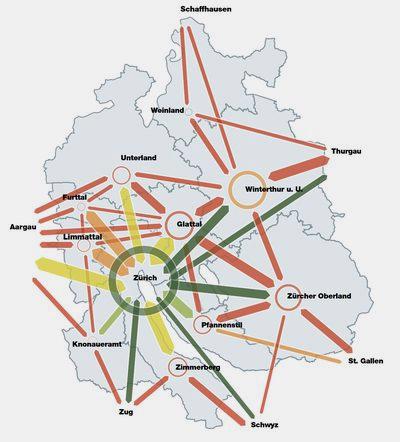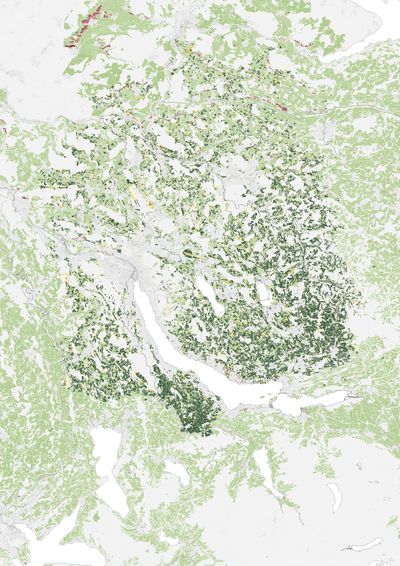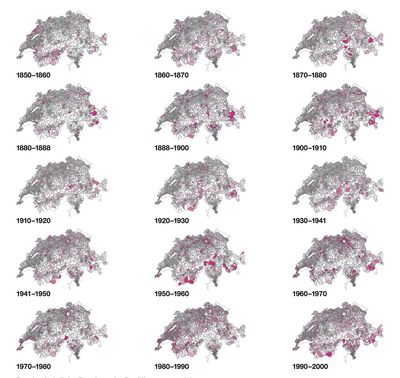AtlasPolitics of LanduseMuriz Djurdjevic and Jan Westerheide
The whole area is orientated to the lake of Geneva. A lot of people travel a long way everyday to the towns along the lake for work. The communes with view to the lake have a bigger growth of inhabitants than others. There is also a lot of industy which produces many workplaces, and the international organizations based in Geneva also employ many workers. Around the lake there is the infrastructure located, traintracks and roads, getting people around it. The growth in Switzerland is overall a lot higher than in France, maybe due to the better infrastructure and other factors. The communes around the city of Geneva have a very big growth, also crossing the border, since a lot of people tend to live in France, but work in Switzerland. The high alpine regions tend to shrink in therms of inhabitants, whereas the communes close to the city and the lake grow. The map shows the growth from 2010 until 2015 in %. Basically taking our commune, Abondance, for example, which lies in the range of 0.0-0.9 % growth, that means it had 1342 inhabitants in 2010 and grew then to 1354 in 2012 and dropped again to 1344 in 2015.
Public Transportation



Personenwege MIV und ÖV

Personenwege MIV und ÖV
Topography



Urban Fabric Extensions

TAXABLE INCOME (CHF) PER INHABITANT 2021. Source: Statistisches Bundesamt.
- 2000–5000 CHF
- 1000–2000 CHF
- 0–1000 CHF
The whole area is orientated to the lake of Geneva. A lot of people travel a long way everyday to the towns along the lake for work. The communes with view to the lake have a bigger growth of inhabitants than others. There is also a lot of industy which produces many workplaces, and the international organizations based in Geneva also employ many workers. Around the lake there is the infrastructure located, traintracks and roads, getting people around it.
Land Use

LAND-USE TYPES IN THE COMMUNES OF FEUSISBERG, ZUMIKON, SPREITENBACH, VOLKETSWIL, AESCH, BACHS, AND FISCHENTHAL. Source: swisstopo.
- Agricultural Land
- Forests
- Building Zones

The whole area is orientated to the lake of Geneva. A lot of people travel a long way everyday to the towns along the lake for work. The communes with view to the lake have a bigger growth of inhabitants than others. There is also a lot of industy which produces many workplaces, and the international organizations based in Geneva also employ many workers. Around the lake there is the infrastructure located, traintracks and roads, getting people around it. Source: Statistisches Bundesamt.
The Built

FLOW OF RESOURCES IN THE CONSTRUCTION INDUSTRY. Source: Federal Statistical Office.
The demographic distribution of retired people in the lac l manique region reveals some significant tendencies. The highly populated area of Geneva demonstrates an increasing percentage of people in the age of retirement. The communes situated on the french part of the agglomeration of geneva exhibit in contrast a low densitiy of people older than 65. Supposedly this effect comes from commuters in the working age populating these areas due to lower living costs. Furthermore can be observed a considerable amount of retired inhabitants in the mountainous areas of the Jura and the Wallisan Alps. We can only speculate if this phenomenon is related to the Landflucht. Young people originally from these areas leaving their communes in prospect of high education and in consequence aspire to a more cosmopolitan lifestyle of the cities.
The distribution of the annual average income per commune shows clearly the expected big difference between Switzerland and France. The average income in Switzerland is about 57 000 CHF whereas in France it is only about 23 000 CHF. But all communes shown in the map, have a higher income than their countries’ average due to the prospering economy of Geneva and its surrounding. Especially the French communes close to Geneva profit the most because of the high percentage of cross-border commuters that get paid a higher salary but have the same costs of life like the rest in France.
Landuse

AGRICULTURAL LAND IN 2022. Source: swisstopo.
- Meadows
- Crops
- Pastures
This political map represents results from the 2011 elections for House of Representatives from Switzerland combined with the French Regional ellections 2015 and illustrates diversity of political opinions within the Lac Leman region. Towards the south, the political views tend toward the centre-right. In the north there is a greater mix of centre left and right. Towards the south-east support for the conservative Christian Democratic People’s Party exists. Disagreement is evident in Geneva region with no one party receiving strong united support from any commune. In Switzerland the commune Bourg-en-Lavaux voted for the Free Democratic Party (FDP) which won by 31%. Bardonnex voted 24% for the Christian Democrate Party. Le Chenit voted 37% for the Social Democrate Party. Aubonne voted for the FDP at a strength of 26%. In France Abodance and Allinges voted for the Union de la Droite Nationale, at 41% and 32% respectively. The colours denote the parties political stance and parties from both countries were alligned under the appropriate colour.
Spatial and Urban Plans

TRAIN LINES, HIGHWAYS AND CANTONAL ROADS IN THE CANTON OF ZURICH. Source: swisstopo.

REDUCTION GOALS IN MIO. TONNES EQ. CO2. Source: Federal Office of the Environment, Evolution of the Carbon Emissions in Switzerland, April 2020.
The distribution of the annual average income per commune shows clearly the expected big difference between Switzerland and France. The average income in Switzerland is about 57 000 CHF whereas in France it is only about 23 000 CHF. But all communes shown in the map, have a higher income than their countries’ average due to the prospering economy of Geneva and its surrounding. Especially the French communes close to Geneva profit the most because of the high percentage of cross-border commuters that get paid a higher salary but have the same costs of life like the rest in France.
Building Zones

AVERAGE INCREASE IN POPULATION PER YEAR. Source: Federal Statistical Office.
- more than 3 %
- 2.0–2.9 %
- 1.0–1.9 %
- 0.0–0.9 %
The demographic distribution of retired people in the lac l manique region reveals some significant tendencies. The highly populated area of Geneva demonstrates an increasing percentage of people in the age of retirement. The communes situated on the french part of the agglomeration of geneva exhibit in contrast a low densitiy of people older than 65. Supposedly this effect comes from commuters in the working age populating these areas due to lower living costs. Furthermore can be observed a considerable amount of retired inhabitants in the mountainous areas of the Jura and the Wallisan Alps. We can only speculate if this phenomenon is related to the Landflucht. Young people originally from these areas leaving their communes in prospect of high education and in consequence aspire to a more cosmopolitan lifestyle of the cities.
Scenic Points

POPULATION IN THE CANTON OF ZURICH IN 2022. Source: Federal Statistical Office.







